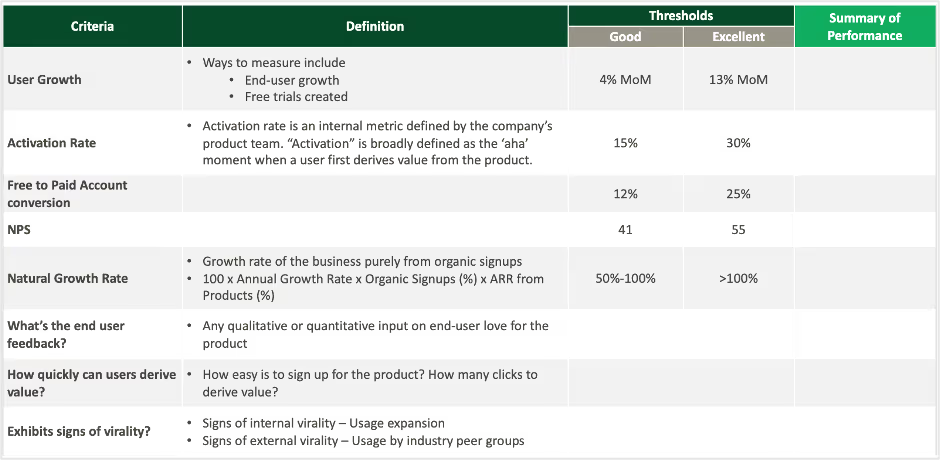Listen now
In our last blog, we wrote extensively about how early-stage startups can build product-led growth. In this blog, we’ll be covering how companies can measure their success toward product-led growth through quantitative and qualitative data.
If you adopt PLG as a driver for your GTM, traditional SaaS metrics can often be lagging indicators of success. Our analysis of companies in the PLG space shows that these companies tend to have a slower start in terms of ARR growth rate. Establishing the right combination of self-serve and bottom-up motion takes time and experimentation. We identified the following metrics could instead serve as leading indicators of whether or not PLG motion is working for your company. Some good quantitative metrics include:
- User growth is the percentage, month over month, of new end users or free trials created. A relatively easy metric to track, a threshold of 4% MoM would be considered good, with 13% MoM or more considered excellent.
- Activation rate needs to be defined by the product management team based on how the product is used, but, in general, a user is considered “activated” when they first derive value from the product. A threshold of 15% is considered good, with 30% or more considered excellent.
- Free-to-paid account conversion rate tracks the percentage of customers using the free product who convert to paying customers. A threshold of 12% of users converting to paid is considered good, with 25% considered excellent.
- Net promoter score (NPS). Since the user experience with the product drives everything, it is critical to track whether or not your product is strongly recommended. The threshold for a good NPS is 41, with 55 or more considered excellent.
- Natural growth rate. This new metric from OpenView is designed specifically for PLG and is explained in more detail here. It basically tracks the rate at which the business is growing organically, excluding all marketing and sales spending. When calculating natural growth rate, for “organic signups” only include those you do not pay for, and for “ARR from Products” only includes revenue from users who started by using the product. 50%-100% is the threshold for a good natural growth rate, with more than 100% considered excellent.
More qualitative measures include:
- End-user feedback – input collected from users about how much they love the product and why – can be critical to understanding what aspects of the product are driving, or holding back, adoption, conversion, and growth.
- How quickly end users derive value from the product depends on making sure signing up and using the product is as frictionless as possible.
- Signs of virality include specific features and processes that specifically drive rapid internal adoption as well as adoption within communities of industry peer groups.

Metrics for evaluating PLG progress. Source – NGP Capital. (Rating your performance against the quantitative metrics, for example, on a scale of 1-4 where 1=excellent and 4=poor, can help you visualize where you stand and where you could improve. You may want to use something like Harvey balls for the more qualitative metrics to get an at-a-glance overview based on these criteria.)
We have observed that revenue growth is slower up to the $5M ARR mark beyond which PLG companies scale very quickly as compared to traditional top-down enterprise sales companies. PLG companies tend to have a much stronger Net Dollar Retention Rate (NDRR) and tend to demonstrate stronger GTM efficiency. The $5M ARR mark could be viewed as a decision point where it may be time to introduce a product-led sales motion. As compared to traditional top-down sales, product-led sales is where you complement a bottoms-up adoption strategy with a sales-assisted conversion strategy.
Product-led growth go-to-market strategies are enabling enterprise software companies across the spectrum to grow faster and more efficiently by leveraging the user experience with their products to build a pipeline of users and convert them into paying customers. We hope these insights serve as a guide for building and scaling PLG businesses.

.svg)






.svg)






